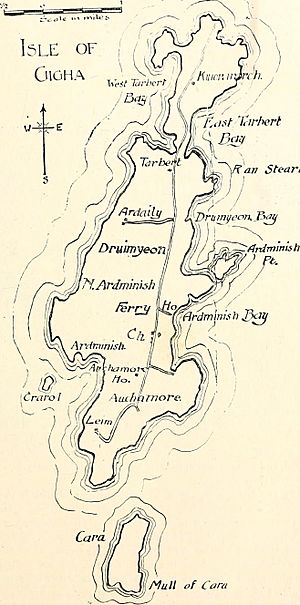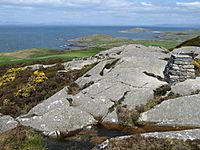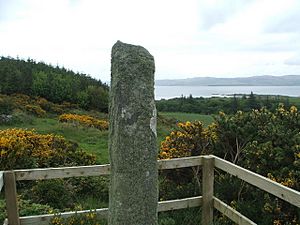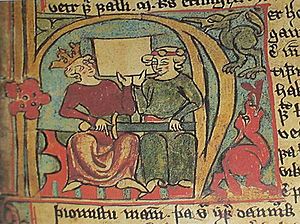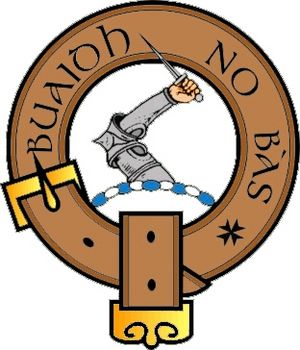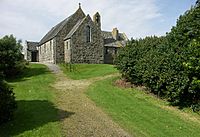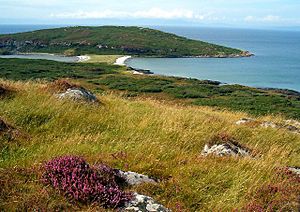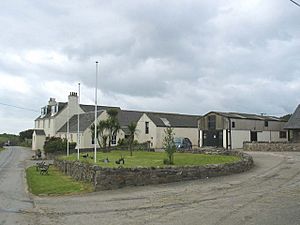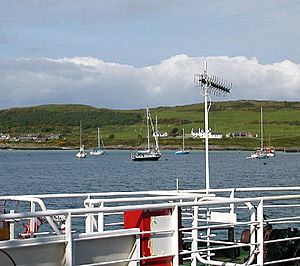Gigha facts for kids
| Gaelic name | Giogha |
|---|---|
| Norse name | Guðey |
| Meaning of name | Old Norse, probably "God's island" or "good island" |
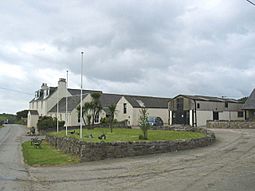 Gigha Hotel |
|
| OS grid reference | NR647498 |
| Coordinates | 55°41′N 5°45′W / 55.68°N 5.75°W |
| Physical geography | |
| Island group | Islay |
| Area | 1,395 ha (3,450 acres) |
| Area rank | 41 |
| Highest elevation | Creag Bhàn 100 m (330 ft) |
| Administration | |
| Sovereign state | United Kingdom |
| Country | Scotland |
| Council area | Argyll and Bute |
| Demographics | |
| Population | 163 |
| Population density | 11.7/km2 (30/sq mi) |
| Largest settlement | Ardminish |
Gigha (pronounced Gee-ha), also known as the Isle of Gigha, is a small island located off the west coast of Kintyre in Scotland. It's part of Argyll and Bute and is home to 163 people. The island has a mild climate with lots of sunshine and very fertile soil, which is great for farming. The main village on Gigha is called Ardminish.
People have lived on Gigha for a very long time, since prehistoric times. It might have been an important place during the ancient Kingdom of Dál Riata. It's also the original home of Clan MacNeill. Over time, the island was controlled by the Norse (Vikings) and then the Lords of the Isles, before becoming part of modern Scotland. It saw many battles during the medieval period.
Gigha's population was highest in the 1700s, with over 700 people. But in the 1900s, the island had many different owners, which made it hard for the community to grow. By the early 2000s, the population had dropped to just 98. However, in 2002, the islanders bought the island themselves in a "community buy-out." This has changed Gigha a lot! Now, the population is growing, and there are new businesses alongside farming and tourism.
Some popular spots on the island include the beautiful Achamore Gardens and lots of amazing wildlife, especially seabirds. The waters around Gigha have also seen many shipwrecks on the rocks and small islands.
Contents
What's in a Name?
The Hebrides islands have been home to people speaking at least four different languages over time. Because of this, many island names can have more than one meaning.
Most experts believe the name "Gigha" comes from the Old Norse words Guðey or Gud-øy. This likely means "good island" or "God's island." An old Norse history book, Hákonar saga Hákonarsonar, actually calls the island Guðey.
However, some people think the Gaelic name might come from Gjáey, meaning "island of the geo" (a narrow, deep inlet of the sea). Another idea is that it comes from the Gaelic Sheela na Gig, which is a symbol of fertility. A person from Gigha is called a Gioghach.
Island Rocks and Land
The main rock that makes up Gigha is called amphibolite. This rock was probably formed from molten rock deep underground a very long time ago. Some parts of the island, especially along the east coast, are made of a different rock called Erins Quartzite. This rock is very old, from the Neoproterozoic age.
You can also see many dark, straight lines of rock called dykes cutting through the island. These formed from magma that pushed up through cracks in the Earth's crust. Parts of the island are also covered by old raised beaches, which show where the sea level used to be much higher after the last Ice Age.
Where is Gigha?
Gigha is about 5 kilometres (3 mi) away from the coast of Kintyre. It stretches about 9.5 km (6 mi) from north to south and is up to 2.5 km (1+1⁄2 mi) wide. The island covers an area of 1,395 hectares (3,450 acres). The highest point is Creag Bhàn, which is only 100 m (330 ft) tall. The middle of the island has a rocky ridge.
The main village, Ardminish, is on the southeast coast. It has a small, safe bay for boats. Other areas include Druimyeon Bay and West and East Tarbert Bays. There are also farms like Kinerarach and Ardailly across the island.
Gigha has a mild climate with more sunshine and fewer frosty days than other parts of Scotland. It usually gets between 1,000 and 1,290 mm (39 and 51 in) of rain each year.
Islands Nearby
Just south of Gigha is Cara Island. To the west is the smaller Craro Island, and to the southeast is Gigalum Island. A sandy path connects Gigha to Eilean Garbh in the northwest. To the north are rocks called An Dubh Sgeir, meaning "black rock." The narrow stretch of water between Gigha and mainland Kintyre is called the Sound of Gigha.
To the west are the larger islands of Islay and Jura. On clear days, you can even see Rathlin Island and northern Ireland from Gigha. There are many other small rocks and tiny islands (skerries) around Gigha.
Gigha's Past
People have lived on Gigha since prehistoric times, and you can still see several standing stones on the island. There are also other old sites like cairns (stone mounds) and duns (ancient forts). An ogham stone, with an ancient writing system, can be found near Kilchattan, but its message is still a mystery.
In the early Middle Ages, Gigha might have been part of the Kingdom of Dál Riata. Some historians think the island might have been the main power center for Conall mac Comgall, a king of Dalriada, in the late 500s.
Viking Times
Nearby Islay was an important place for the Norse (Vikings) who controlled the Hebrides. Gigha later became part of the Kingdom of the Isles. The island's name itself seems to be Norse, and there are other Norse place names nearby, like Gigalum and Cnoc Haco (possibly "Haakon's hill").
In 1849, a Viking grave was found at East Tarbert Bay. It contained items like a bronze weighing scale from the 900s.
Before a big battle called the Battle of Largs, King Haakon IV of Norway is said to have visited Gigha. An old Icelandic saga, Hákonar saga Hákonarsonar, tells us that King Haakon anchored at Gigha. During his stay, an Abbot from a monastery asked for his protection, which the King granted in writing.
The Lords of the Isles
After a time of conflict in Scotland, John of Islay, Lord of the Isles, gained control over many islands, including Gigha. He was a powerful figure who ruled over much of the western coast of Scotland and the Hebrides. His control of Gigha was confirmed by Scottish kings in the 1300s.
The MacNeills of Gigha
Gigha is the historic home of the Clan MacNeill. This clan has its own unique tartan and badge, different from the larger Clan MacNeil of Barra.
The MacNeills of Gigha were important people. They were the traditional keepers of Castle Sween for the Lords of the Isles. In 1530, the MacNeill of Gigha was even called the "chief of the clan and name of Macneils." However, as the power of the Clan Campbell grew, the MacNeills of Gigha became less influential.
The MacNeills owned Gigha for a long time, from 1493 until the 1800s, with only a few short breaks. But owning the island wasn't always easy. In 1530, a pirate named Ailean nan Sop attacked Gigha and killed the MacNeill of Taynish and many islanders. Later, in 1542, the island's ownership papers were lost when eleven Gigha gentlemen were killed by raiders.
Battles and Changes
In 1554, the MacNeills gave up their Gigha lands to the MacDonalds, but this didn't stop the fighting. In 1567, the island was "ravaged" by the Macleans of Duart. By 1587, there was so much fighting between West Highland clans that the government tried to stop it with something called the General Band.
Despite this, Lachlan Mor MacLean of Duart attacked the MacDonald islands of Islay and Gigha, killing many people. He then surrounded Angus MacDonald, 8th of Dunnyveg at his castle on Islay. The siege ended when MacDonald agreed to give up half of his lands on Islay. However, MacDonald then attacked the MacLean islands with help from other clans, including the MacNeills of Gigha.
In 1590, Angus of Islay sold Gigha to John Campbell of Cawdor, who then immediately sold it back to Neil MacNeill of Taynish. The old church at Kilchattan from this time has some beautifully carved medieval grave slabs.
Gigha in the 1600s
A visitor named Martin Martin wrote about Gigha in the late 1600s:
This island is mostly good for farming, but some parts are rocky. The soil is brown and clayey, good for growing oats and barley. They raise cows, horses, and sheep here. There is a church called Kilchattan, with an altar and a large stone font. Many tombstones are in and around the church. The Macneil family, who owned most of the island, are buried on the east side of the church. Most tombs have a two-handed sword carved on them, and one has a carving of a person. This island has no wood, only a few juniper bushes on the small hills.
King William II of Scotland visited Gigha in 1689. The MacNeills stayed loyal to the king during this time and also during the Jacobite rebellion of 1745.
Recent History
In the 1700s, Gigha's population reached over 600 people. But by the end of the 1800s, it had dropped to under 400. After 500 years, the MacNeills sold the island in 1865 for £49,000 to James Williams Scarlett. His son, William James Scarlett, built the large house called Achamore. The Scarlett family owned Gigha until 1919.
During the 1900s, Gigha had several different owners. Sir James Horlick bought the island in 1944. He was known as a kind owner who supported dairy farming and created the famous Achamore Gardens. Later owners included David Landale, who started a fish farm. Over the years, not much new development happened, and some owners were not as popular. By the 1960s, only 163 people lived on Gigha, and by the early 2000s, the population was just 98. Many houses were in poor condition.
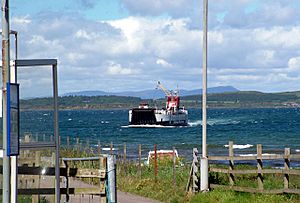
How Gigha's Population Changed
| Year | Population |
| 1755 | 514 |
| 1792 | 614 |
| 1801 | 556 |
| 1821 | 573 |
| 1841 | 550 |
| 1881 | 378 |
| 1891 | 398 |
| Year | Population |
| 1911 | 326 |
| 1931 | 240 |
| 1951 | 190 |
| 1961 | 163 |
| 1981 | 153 |
| 1991 | 143 |
| 2001 | 110 |
| 2011 | 163 |
Note: The numbers for 1755–1841 include Cara Island.
Islanders Take Control
The problems caused by private landlords ended in March 2002. The islanders, with help from grants and loans from the National Lottery and Highlands and Islands Enterprise, bought the island for £4 million. They now own it through a group called the Isle of Gigha Heritage Trust. Because of this, March 15th, the day they bought the island, is celebrated as Gigha's "independence day."
One million pounds of the money was a short-term loan. To pay it back, they sold Achamore House (but not its gardens) to Don Dennis, a businessman from California. He now runs a flower essences business and boat tours from the house, which is also a bed and breakfast. The islanders also raised another £200,000 themselves through various fundraising events. This allowed them to pay back the loan on March 15, 2004.
Since the community bought the island, many new businesses have started on Gigha, helping the local economy. These include the award-winning Boathouse Café Bar. The island's population and economy have started to get better because of these activities.
Gigha's Economy
Gigha's economy mainly relies on livestock farming, tourism, and some fishing. Since the community bought the island, there have been efforts to add more types of businesses. There is also a fish farm on the island.
About 365 hectares (900 acres) of land is farmed, making Gigha one of the most fertile islands in Scotland for its size. Ayrshire cattle are raised here.
In October 2006, the population reached 150, which was a more than 50 percent increase since the 2002 buy-out. Willie McSporran, a former chairman of the Heritage Trust, said that the trust had reversed 300 years of population decline by encouraging new homes and businesses. Between 2001 and 2011, the island's population grew by over 45%.
Wind Power
The Heritage Trust created Gigha Renewable Energy Ltd. to buy and run three Vestas V27 wind turbines. These are known locally as The Dancing Ladies or Creideas, Dòchas is Carthannas (Gaelic for Faith, Hope and Charity). They started working on January 21, 2005, and can produce up to 675 kW of power. The island makes money by selling the electricity to the power grid. The people of Gigha control the whole project, and the money earned is used to help the community. In 2016, two batteries were added to the system to store power.
Getting Around Gigha
Gigha has a grass landing strip for small planes near the southern end of the island. You need permission to land there. It's one of the closest airstrips to Glasgow International Airport, usually a 20 to 30-minute flight away.
A Caledonian MacBrayne ferry connects Ardminish, the island's only village, to Tayinloan on the Kintyre peninsula. From Tayinloan, you can connect to the A83 road on the mainland.
There is a primary school on the island. However, older students who go to secondary school must travel to the mainland for their education. Ardminish has the pier, post office, and a shop.
Fun Things to Do
Some popular attractions on Gigha include the 20.2 hectares (50 acres) Achamore Gardens. These gardens were started in 1945 by Sir James Horlick and are famous for their beautiful rhododendrons and azaleas. The island also has many sandy beaches and the ruins of the thirteenth-century St Catan's Chapel. There used to be a nine-hole golf course, but it is not currently in use.
Gigha's Wildlife
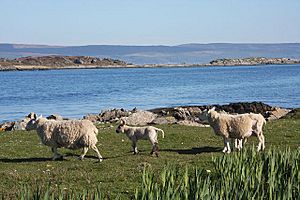
Because Gigha is on the eastern side of the Atlantic Ocean, it attracts many different seabirds like guillemots and eider ducks, which nest on Eilean Garbh. Inland, you can find ducks such as mallards, teal, wigeon, and pochard. You might also see herons, snipe, pheasant, and red grouse. Hooded crows and jackdaws are common, but geese only visit sometimes.
There are not many types of mammals on Gigha. You won't find red deer, stoats, weasels, red foxes, or hares here. In the mid-1900s, Gigha had eight boats that fished for cod and lobster, but commercial fishing stopped some time ago.
Shipwrecks Around Gigha
Many ships have been wrecked off Gigha's coasts. In August 1886, the Staffa ran aground on rocks west of Craro. All crew and 21 passengers were saved the next morning. On April 8, 1894, the steamship Udea was lost on the same rocks while carrying coal and iron.
On September 16, 1940, during World War II, the British steam liner Aska was bombed by a German aircraft south of Gigha. It was carrying French troops. Twelve crew members died, but 75 survivors were rescued. The burning Aska then drifted onto Cara Island and was wrecked there. Four years later, the Mon Cousu was purposely sunk in the Sound of Gigha and used for bombing practice. In 1991, the Russian factory ship Kartli was hit by two huge waves off Islay and ran aground at Port Ban after its crew were evacuated. Forty-seven crew members were rescued by helicopter, but four men died in the accident.
Gigha's Culture
Gigha used to have a strong tradition of harping, especially with a family called Mac an Bhreatnaigh (Galbraith). They were active in Gigha and Kintyre. In the 1990s, many island residents spoke Gaelic, though the numbers have gone down in recent years.
The Gaelic Language
Gaelic was historically very strong on Gigha. In the 1901 and 1921 census reports, over 75% of the islanders spoke Gaelic. By 1971, this had dropped to between 25-49.9%. In the 2001 census, only 14% of the population spoke Gaelic.
In 2008, Henri Macaulay of Gigha Gallery received money to hold Gaelic-learning weekends on the island. These weekends combine cultural revival with tourism. They focus on conversation and music and take place during the winter months.
See also
 In Spanish: Isla de Gigha para niños
In Spanish: Isla de Gigha para niños


